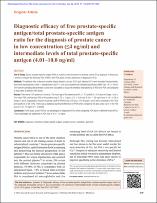| dc.contributor.author | Çalışkan, Selahattin | |
| dc.date.accessioned | 2019-05-13T08:58:35Z | |
| dc.date.available | 2019-05-13T08:58:35Z | |
| dc.date.issued | 2017 | |
| dc.identifier.citation | Çalışkan, S. (2017). Diagnostic efficacy of free prostate-specific antigen/total prostate-specific antigen ratio for
the diagnosis of prostate cancer in low concentration (≤4 ng/ml) and intermediate levels of total prostate-specific antigen (4.01–10.0 ng/ml). Journal of Cancer Research and Therapeutics, 13(2), 279-283. | en_US |
| dc.identifier.issn | 0973-1482 | |
| dc.identifier.uri | https://doi.org/10.4103/0973-1482.183177 | |
| dc.identifier.uri | https://hdl.handle.net/11491/1162 | |
| dc.description.abstract | Aim of Study: Serum prostate-specific antigen (PSA) is a useful tumor biomarker for prostate cancer (PCa) diagnosis. In this study, I aimed to compare the free/total PSA (fPSA%) with PSA alone for their usefulness in diagnosis for PCa. Methods: The patients who underwent prostate biopsy between January 2010 and January 2015 were evaluated retrospectively. Data were expressed as a mean + standard error and P < 0.05 as considered with statistical significance (Med Calc 14.12-2014). The receiver operating characteristic curves were calculated to study the sensitivity and specificity of fPSA and PSA and compared to each other in different PSA levels. Results: There were 1055 patients in the study. The mean age of the patients was 64.2 + 7.5 and 66.3 + 6.4 years in Groups 1 and 2. The mean PSA and free/total PSA of the patients was 2.79 + 1 ng/ml, 0.2 + 0.08 and 6.49 + 1.59 ng/ml and 0.19 + 0.09 in Groups 1 and 2, respectively. I found the optimal cutoff for fPSA% was ?18 and ?14 in Groups 1 and 2 with a sensitivity of 62-45% and specificity of 58-79%. There was a statistical significant difference for fPSA when comparing the area under curve in the PSA level of 4.01-10 ng/ml (P = 0.0009). Conclusion: In this study, serum fPSA% has advantages for diagnosis of PCa when comparing PSA alone in different levels of PSA. These advantages are significant in PSA level of 4.01-10 ng/ml. © 2017 Indian Journal of Ophthalmology | Published by Wolters Kluwer - Medknow. | en_US |
| dc.language.iso | eng | |
| dc.publisher | Wolters Kluwer - Medknow | en_US |
| dc.relation.isversionof | 10.4103/0973-1482.183177 | en_US |
| dc.rights | info:eu-repo/semantics/openAccess | en_US |
| dc.rights | Attribution-NonCommercial-ShareAlike 3.0 Unported (CC BY-NC-SA 3.0) | * |
| dc.rights.uri | https://creativecommons.org/licenses/by-nc-sa/3.0/ | * |
| dc.subject | Diagnosis | en_US |
| dc.subject | Free/Total Prostate-Specific Antigen | en_US |
| dc.subject | Prostate Cancer | en_US |
| dc.subject | Sensitivity | en_US |
| dc.subject | Specificity | en_US |
| dc.title | Diagnostic efficacy of free prostate-specific antigen/total prostate-specific antigen ratio for the diagnosis of prostate cancer in low concentration (≤4 ng/ml) and intermediate levels of total prostate-specific antigen (4.01-10.0 ng/ml) | en_US |
| dc.type | article | en_US |
| dc.relation.journal | Journal of Cancer Research and Therapeutics | en_US |
| dc.department | Hitit Üniversitesi, Tıp Fakültesi, Cerrahi Tıp Bilimleri Bölümü | en_US |
| dc.identifier.volume | 13 | en_US |
| dc.identifier.issue | 2 | en_US |
| dc.identifier.startpage | 279 | en_US |
| dc.identifier.endpage | 283 | en_US |
| dc.relation.publicationcategory | Makale - Uluslararası Hakemli Dergi - Kurum Öğretim Elemanı | en_US |



















